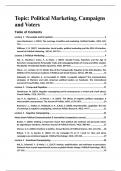Topic: Political Marketing, Campaigns
and Voters
Table of Contents
Lecture 1 – The people and its opinion................................................................................3
Lees-Marshment, J. (2001). The marriage of politics and marketing. Political Studies, 49(4), 692-
713................................................................................................................................................6
Williams, C. B. (2017). Introduction: Social media, political marketing and the 2016 US election.
Journal of Political Marketing, 16(3-4), 207-211...........................................................................9
Lecture 2: Political Marketing.............................................................................................9
Nai, A., Martínez i Coma, F., & Maier, J. (2019). Donald Trump, Populism, and the Age of
Extremes: Comparing the Personality Traits and Campaigning Styles of Trump and Other Leaders
Worldwide. Presidential Studies Quarterly, 49(3), 609-643........................................................14
Oliver, J. E., & Rahn, W. M. (2016). Rise of the Trumpenvolk: Populism in the 2016 Election. The
ANNALS of the American Academy of Political and Social Science, 667(1), 189-206....................15
Zulianello, M., Albertini, A., & Ceccobelli, D. (2018). A populist zeitgeist? The communication
strategies of Western and Latin American political leaders on Facebook. The International
Journal of Press/Politics, 23(4), 439-457.....................................................................................16
Lecture 3 – Trump and Populism.......................................................................................17
Haselmayer, M. (2019). Negative campaigning and its consequences: a review and a look ahead.
French Politics, 17(3), 355-372....................................................................................................19
Lau, R. R., Sigelman, L., & Rovner, I. B. (2007). The effects of negative political campaigns: A
meta-analytic reassessment. The Journal of Politics, 69(4), 1176-1209.......................................20
Roseman, I. J., Mattes, K., Redlawsk, D. P., & Katz, S. (2020). Reprehensible, Laughable: The role
of contempt in negative campaigning. American Politics Research, 48(1), 44-77........................21
Lecture 4 – Negative Campaigning...................................................................................22
Notes from Political Communication & Journalism (compulsory course)...........................25
Brader, T. (2005). Striking a responsive chord: How political ads motivate and persuade voters
by appealing to emotions. American Journal of Political Science, 49(2), 388-405........................27
Marcus, G. E. (2000). Emotions in politics. Annual Review of Political Science, 3(1), 221-250.....28
Ridout, T. N., & Searles, K. (2011). It's my campaign I'll cry if I want to: How and when
campaigns use emotional appeals. Political Psychology, 32(3), 439-458.....................................29
Lecture 5 – Emotional Campaigning.................................................................................30
Nai, A., Schemeil, Y., & Marie, J. L. (2017). Anxiety, sophistication, and resistance to persuasion:
Evidence from a quasi-experimental survey on global climate change. Political Psychology, 38(1),
137-156.......................................................................................................................................34
, Walter, A. S., & Drochon, H. (2020). Conspiracy thinking in Europe and America: A comparative
study. Political Studies, 0032321720972616...............................................................................35
Lecture 6 – Persuasion and conspiracy theories................................................................35
Lau, R. R., Andersen, D. J., & Redlawsk, D. P. (2008). An exploration of correct voting in recent
US presidential elections. American Journal of Political Science, 52(2), 395-411.........................37
Lau, R. R., & Redlawsk, D. P. (2001). Advantages and disadvantages of cognitive heuristics in
political decision making. American Journal of Political Science, 951-971...................................38
Lecture 7..........................................................................................................................39
,Relevant notes about the course:
- Written academic assignment (30%)
o Case study, visual examples, reference to course theories
o The goal of the case study is to illustrate through a specific example
a theoretical point discussed in class and/or in the weekly readings
o Outside of your comfort zone
o 900 words
o Can be from any era or a fictional example (need to ask him tho)
- Exam (70%)
o Open book
o Cite literature during
o 3-6 hours, 3000 words(ish)
- Overall grade needs to be 5.5
- Information in the syllabus is the reference
- Reflect on concrete examples always come up with examples when you
encounter new concepts
- Always try to make connections between topics/concepts/weeks
Lecture 1 – The people and its opinion
- 2 main roles of political parties to communicate with citizens
o Political standpoint is to attract voters
Shift votes via negative campaigning attracting votes and
changing peoples opinion (psychological component to like
you)
o Political-sociological standpoint is to mobilize people
- Opinions = an evaluation of what someone thinks about a thing;
collections of feelings and attitudes towards something
- Monkey cage
- Positivism epistemological framework
What are opinions?
- Opinions are a key element in contemporary ‘models’ of political
behaviour
- 2 examples of conventional political behaviour
o Emotional
o Protest
- Assumption: measuring opinions allows to predict (voting) behaviour
o Opinions often translate into behaviours
o This creates a media obsession with opinions (frame that political
journalists use to describe political events)
o Political consultants are key players in helping politicians to shape
behaviours
Opinions are central to how we think about politics
- Historically, the focus on opinions is pretty recent
o 3 models of political behaviours (try to synthesize our
understanding of opinion formation)
Rational (economic) models
Central element: individual preferences
, Behaviours are driven by your preferences.
‘homo oeconomicus’ customer with simplified
psychology but full information
o Able to chose among alternatives
o Driven by logic
o Stable taste and preferences
o If identical circumstances identical choice
o Egotistical (no altruistic behaviours) and decide
‘rationally’
Critique:
o This makes sense most of the time, but are our
preferences always our motivator?
o Do we have stable preferences (key assumption
of model)? Opinions change
o Does not take into account feelings (driven by
logic)
o The assumption that one person can know their
preference about everything.
Model shows 8 sectors
Sociological models
40-50s
First time from a scientific standpoint that we can see
whether an opinion changed
Goal: to show that political propaganda works
o Results: preferences are stable in time, with
very little change from political communication
Key factor: Individual values (brand loyalties) are
stable in time
o Socio-economic values (how your upbringing
influences you)
o Religious affiliation
o Residence (urban vs. rural)
Urban concentration shrinks, rural
expands
Social environment matters a lot because
its drives our values
Critique: if preferences are stable in time, how can we
explain fluctuations in voting choices (aggregated,
individuals)?
o We need a more encompassing model, that
takes into account
Socio-psychological models (80-90s)
Michigan model
Builds on the premises of the Colombia mode
(importance of stable preferences to shape behaviour)
Adds a psychological perspective to account for short-
term fluctuations
Focus on three behavioural dispositions





